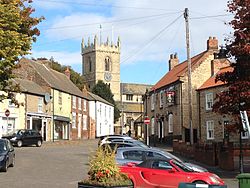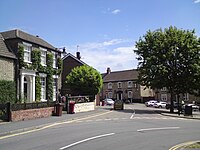Winterton: Difference between revisions
No edit summary |
mNo edit summary |
||
| Line 15: | Line 15: | ||
|LG district=North Lincolnshire | |LG district=North Lincolnshire | ||
}} | }} | ||
'''Winterton''' is a small town in [[Lincolnshire]], five miles | '''Winterton''' is a small town in [[Lincolnshire]], five miles north-east of [[Scunthorpe]], and with an estimated population of just 4,700. The major north-south/east-west streets of Winterton are Market Street and Northlands Road. | ||
Winterton is near the banks of the [[Humber]] and is eight miles south-west of the Humber Bridge which can be seen from many parts of the town. | Winterton is near the banks of the [[Humber]] and is eight miles south-west of the [[Humber Bridge]] which can be seen from many parts of the town. | ||
Professor Cameron in ''The Place Names of Lincolnshire''<ref>''The Place Names of Lincolnshire'', Vol 6, p125, Cameron</ref> opined that the village's name meant the farmstead, the village or the estate of the 'Winteringas', who were perhaps named from a chieftain or progenitor named ''Winter'' or ''Wintra''. In the [[Domesday Book]] of 1086 it is called variously "Wintrintune", once; "Wintrintone", four times; "Wintritone", twice and "Wintretune", once. | Professor Cameron in ''The Place Names of Lincolnshire''<ref>''The Place Names of Lincolnshire'', Vol 6, p125, Cameron</ref> opined that the village's name meant the farmstead, the village or the estate of the 'Winteringas', who were perhaps named from a chieftain or progenitor named ''Winter'' or ''Wintra''. In the [[Domesday Book]] of 1086 it is called variously "Wintrintune", once; "Wintrintone", four times; "Wintritone", twice and "Wintretune", once. | ||
| Line 27: | Line 27: | ||
Winterton has a history going back to Roman times and several large mosaic floors and other Roman remains have been found there.<ref name="Steed">I. M. Stead (1966). Winterton Roman Villa: An Interim Report. The Antiquaries Journal, 46, pp 72-84. doi:10.1017/S0003581500062892. </ref> | Winterton has a history going back to Roman times and several large mosaic floors and other Roman remains have been found there.<ref name="Steed">I. M. Stead (1966). Winterton Roman Villa: An Interim Report. The Antiquaries Journal, 46, pp 72-84. doi:10.1017/S0003581500062892. </ref> | ||
In October 1968, during road-widening works on the A1077, workers found a massive stone coffin containing a skeleton later identified as being that of a young woman aged between 20 and 25 years of age, who stood 5'3" tall. She was of high status, as evidenced by the high quality of the coffin made from a single block of limestone and she was also found to be laid on a sheet of lead. Down the hill from this spot are the remains of one of the Winterton Roman villas, which is famous for its mosaic pavements where it is most likely she lived.<ref name="Steed"/> | In October 1968, during road-widening works on the A1077, workers found a massive stone coffin containing a skeleton, later identified as being that of a young woman aged between 20 and 25 years of age, who stood 5'3" tall. She was of high status, as evidenced by the high quality of the coffin made from a single block of limestone and she was also found to be laid on a sheet of lead. Down the hill from this spot are the remains of one of the Winterton Roman villas, which is famous for its mosaic pavements where it is most likely she lived.<ref name="Steed"/> | ||
The mouth of the valley of the Winterton Beck once provided a harbour on the Humber. It is now silted but the small harbour of Winteringham Haven still exists. Winterton, further inland along the limestone ridge. | The mouth of the valley of the Winterton Beck once provided a harbour on the Humber. It is now silted but the small harbour of Winteringham Haven still exists. Winterton, further inland along the limestone ridge. | ||
Latest revision as of 09:24, 10 November 2017
| Winterton | |
| Lincolnshire | |
|---|---|
 All Saints Church, Winterton | |
| Location | |
| Grid reference: | SE926185 |
| Location: | 53°39’18"N, -0°35’52"W |
| Data | |
| Population: | 4,729 (2001) |
| Post town: | Scunthorpe |
| Postcode: | DN15 |
| Dialling code: | 01724 |
| Local Government | |
| Council: | North Lincolnshire |
| Parliamentary constituency: |
Brigg and Goole |
Winterton is a small town in Lincolnshire, five miles north-east of Scunthorpe, and with an estimated population of just 4,700. The major north-south/east-west streets of Winterton are Market Street and Northlands Road.
Winterton is near the banks of the Humber and is eight miles south-west of the Humber Bridge which can be seen from many parts of the town.
Professor Cameron in The Place Names of Lincolnshire[1] opined that the village's name meant the farmstead, the village or the estate of the 'Winteringas', who were perhaps named from a chieftain or progenitor named Winter or Wintra. In the Domesday Book of 1086 it is called variously "Wintrintune", once; "Wintrintone", four times; "Wintritone", twice and "Wintretune", once.
After the conventional Woden, Winta heads the list of the Kings of Lindsey, though any relation is speculative.
History

Winterton has a history going back to Roman times and several large mosaic floors and other Roman remains have been found there.[2]
In October 1968, during road-widening works on the A1077, workers found a massive stone coffin containing a skeleton, later identified as being that of a young woman aged between 20 and 25 years of age, who stood 5'3" tall. She was of high status, as evidenced by the high quality of the coffin made from a single block of limestone and she was also found to be laid on a sheet of lead. Down the hill from this spot are the remains of one of the Winterton Roman villas, which is famous for its mosaic pavements where it is most likely she lived.[2]
The mouth of the valley of the Winterton Beck once provided a harbour on the Humber. It is now silted but the small harbour of Winteringham Haven still exists. Winterton, further inland along the limestone ridge.
Outside links
| ("Wikimedia Commons" has material about Winterton) |
